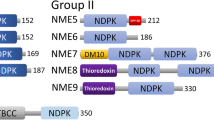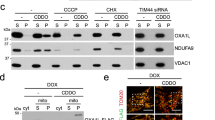Abstract
According to functional studies, the higher IF1 content reported in mitochondria of cancerous cells is supposed to induce a higher association with the F1F0 complex than in normal cells and therefore a better inhibition of its ATPase activity. The first structural evidence supporting this prediction is here presented. Densitometric analyses of Western blotting experiments indicated a 2-fold increase in IF1 content of AS-30D submitochondrial particles compared to normal rat liver controls. The ratio of IF1/F1 α subunit increased similarly as judged by Westernblot analyses. This IF1 overexpression correlated with a slower rate of IF1 release (F1F0-ATPase activation) from the F1F0 complex in AS-30D than in normal rat liver submitochondrial particles. The IF1-IF1, γ-IF1, and α-IF1 cross-linkages previously formed with dithiobis(succinimidylpropionate) in bovine F1F0I and IF1 complexes (Minauro-Sanmiguel, F., Bravo, C., and García, J. J. (2002). J. Bioenerg. Biomembr. 34, 433–443) were reproduced in the F1F0I-ATP synthase of hepatoma AS-30D cells. However, a much lower yield of IF1 cross-linkages was found in normal rat liver particles which made them almost undetectable in SMP as well as in the immunoprecipitated F1F0I complex. Modeling in vivo IF1 overexpression of cancerous cells by in vitro reconstitution of excess recombinant IF1 with rat liver submitochondrial particles devoid of IF1 reproduced the same IF1 cross-linkages observed in AS-30D particles.
Similar content being viewed by others
REFERENCES
Aggeler, R., Coons, J., Taylor, S. W., Gosh, S. S., García, J. J., Capaldi, R. A., and Marusich, M. (2002). J. Biol. Chem. 277, 33906-33912.
Ala-Rämi, A., Ylitalo, K. V., y Hassinen, I. E. (2003). Basic Res Cardiol. 98, 250-258.
Capuano, F., Guerrieri, F., and Papa. S. (1997). J. Bioenerg. Biomembr. 29, 379-384.
Capuano, F., Varone, D., D'Eri, N., Russo, E., Tommasi, S., Montemurro, S., Prete, F., and Papa, S. (1996). Biochem. Mol. Biol. 38, 1013-1022.
Chang, J. P., Gibley, C. W., Jr., and Ichinoe, K. (1967). Cancer Res. 27, 2065
Chernyak, B. V., Dedov, V. N., and Gabai, V. L. (1994). FEBS Lett. 337, 56-59.
Chernyak, B. V., Dukhovich, V.F., and Khodjaev, E. Y. (1991). Arch. Biochem. Biophys. 286, 604-609.
García, J. J., Tuena de Gómez-Puyou, M., and Gómez-Puyou, A. (1995). J. Bioenerg. Biomembr. 27, 127-136.
Gómez-Puyou, A., Tuena de Gómez-Puyou, M., and Ernster, L. (1979). Biochim. Biophys. Acta 547, 252-257.
Harris, D. A., Von Tscharner, V., and Radda, G. K. (1979). Biochim. Biophys. Acta 548, 72-84.
Inouye, S., and Inouye, M. (1985). Nuclei Acids Res. 9, 3101-3110.
Klein, G., Satre, M., Zaccai, G., and Vignais, P. V. (1982). Biochim. Biophys. Acta 681, 226-232.
Ko, H. Y., Delannoy, M., Hullihen, J., Chiu, W., and Pedersen, P. L. (2003). J. Biol. Chem. 278, 12305-12309.
Kuzela, S., Kolarov, J., Krempasky, V., Hatalova, I., Lakota, J., and Ujhazy, V. (1977). Neoplasma 24, 559-562.
Lebowitz, M. S., and Pedersen. P. L. (1993). Arch. Biochem. Biophys. 301, 64-70.
Lowry, O. H., Rosegrough, N. J., Farr, A. L., and Randall, R. J. (1951). J. Biol. Chem. 193, 265-275.
Luciakova, K., and Kuzela, S. (1984). FEBS Lett. 177, 85-88.
Minauro-Sanmiguel, F., Bravo, C., and García J. J. (2002). J. Bioenerg. Biomembr. 34, 433-443.
Moreadith, R., and Fiskum, G. (1984). Anal. Biochem. 137, 360-367.
Moreno-Sánchez, R. (1985). J. Biol. Chem. 260, 4028-4034.
Pullman, M. E., and Monroy, G. C. (1963). J. Biol. Chem. 238, 3762-3769.
Rouslin, W. (1991). J. Bioenerg. Biomembr. 23, 873-888.
Rouslin, W., and Broge, C. (1996). J. Biol. Chem. 271, 23638-23641.
Schwerzmann, K., Hullihen, J., and Pedersen. P. L. (1982). J. Biol. Chem. 257, 9555-9560.
Schwerzmann, K., and Pedersen, P. (1986). Arch. Biochem. Biophys. 250, 1-18.
Smith, D. F., Walborg, E. F., Jr., and Chang, J. P. (1970). Cancer Res. 30, 2306
Zheng, C. F., Wang, T. T., and Weiner, H. (1993). Alcohol Clin. Exp. Res. 17, 828-831.
Author information
Authors and Affiliations
Rights and permissions
About this article
Cite this article
Bravo, C., Minauro-Sanmiguel, F., Morales-Ríos, E. et al. Overexpression of the Inhibitor Protein IF1 in AS-30D Hepatoma Produces a Higher Association with Mitochondrial F1F0 ATP Synthase Compared to Normal Rat Liver: Functional and Cross-Linking Studies. J Bioenerg Biomembr 36, 257–264 (2004). https://doi.org/10.1023/B:JOBB.0000031977.99479.ea
Issue Date:
DOI: https://doi.org/10.1023/B:JOBB.0000031977.99479.ea




